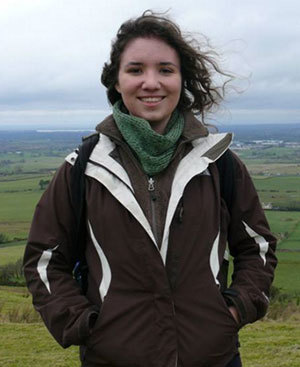
Rebecca Mayus '15
Ph.D. student, The Ohio State University
If you had asked me at the beginning of my freshman year at Notre Dame whether I planned to pursue a career in anthropology, I almost certainly would not have replied in the affirmative. In fact, my response would likely have been more along the lines of “What exactly is anthropology?”
Like many new college students, I had never been properly introduced to the field, and had no real concept of what it was that anthropologists actually did. All I had to go by were a few largely random names that had cropped up in the news or my past schoolwork: Paul Farmer, Franz Boas, Jane Goodall, Indiana Jones (all right, maybe that last one is a little out of place).
The careers of these individuals spanned a wide number of seemingly disparate topics, but from what I could tell, all of their work seemed worthwhile and exciting. It was enough to make me curious, and this curiosity led me to sign up for an introductory lecture on human ethology, taught by James McKenna, the Rev. Edmund P. Joyce, C.S.C., Professor of Anthropology.
Needless to say, I was not disappointed by the course. Never before had I been introduced to such an elegant combination of the sciences and the humanities. Over the course of a single lecture, a discussion of human evolution could give way to comparative studies of primate behavior, which might then lead to the detailed history of a certain culture’s child-rearing practices, and so on, in a way that was somehow completely logical and highly enjoyable.
For the first time, I realized just how related were many of the fields I’d once considered only in isolation. Biology, history, sociology—everything seemed to come together into the perfect interdisciplinary mix that was anthropology. For someone like me, who was never good at picking just one topic to study, it was a dream come true.
I found myself declaring an anthropology major soon after taking Professor McKenna’s course, and I never looked back. Every class, led by passionate and engaging professors, was just as rewarding as the first.
As I became more involved in the department, opportunities began to arise outside of the classroom. Between my sophomore and junior year, the department offered me a summer internship with the Smithsonian Institution National Museum of Natural History. I spent the first half of the summer in Washington, D.C., helping Smithsonian researchers at the Arctic Studies Center compile their past work.
The second half constituted my first experience in archaeological fieldwork. It was a whirlwind six weeks spent living on a boat, travelling along the Lower North Shore of Quebec and excavating a site once inhabited by Basque whalers and cod fishermen.
The excavation involved long days of hard work, punctuated by often-hectic supply runs across choppy seas. I loved every minute of it. Every time I uncovered a new artifact at the site—even if it were little more than the rusted shell of a nail or a bit of terra cotta tile—I was filled with a sense of excitement. Here were the remnants of the past, which had lain patiently for hundreds of years, ready for the day when archaeologists would discover them once again and carefully reconstruct the meaning they had once held to persons now long gone.
This fieldwork sparked my deep interest in archaeology—an interest that would be reaffirmed in my junior year, when I took Associate Professor Susan Sheridan’s human osteology course. During the course, I was introduced to bioarchaeology, the study of human remains in archaeological contexts, and had a chance to work with an actual archaeological assemblage—a group of skeletons associated with a Byzantine monastery.
I remember seeing one of the crania from the collection for the first time: 1,500 years old, delicate and stained a light brown from age and dirt. Again, I marveled at the fact that something so incredible had managed to persist for so long. These bones had once belonged to a living human, and they held stories about that human’s health and life.
I knew, almost immediately, that I wanted to dedicate my career to reconstructing those stories through bioarchaeological research. I continued working with Professor Sheridan throughout the rest of my time at Notre Dame, and after graduating I moved to The Ohio State University to continue my studies. My goal now is to earn a Ph.D. in anthropology with an emphasis on bioarchaeology.
As I finish up my first year of graduate school, I look back and realize that I owe a great deal to the Department of Anthropology at Notre Dame. Were it not for the enthusiasm of the faculty and staff, I might never have ended up studying a field that I find truly exciting and satisfying. Moreover, the department gave me the knowledge, the research experience, and the opportunities necessary to succeed as I pursue a career in anthropology. I have formed a great network of mentors and friends at Notre Dame, and I look forward to working with these individuals for many years to come.